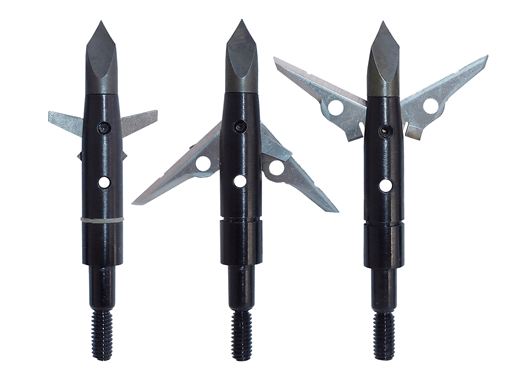
When I started hunting, the idea of a fixed blade broadhead on a shaft following two nodal points really worked on my nerves. Just the idea that a “flying” surface would cross and recross the flight line, creating various degrees of drag during the process simply did not sit well with me. That and the generally smaller cutting diameter of a fixed blade broad head made me think it’s absurd to shoot anything but a mechanical head…
My thoughts on the matter have changed a bit, now that I have actually spent some decent time in the field, but I still like my mechanicals.
The Ulmer Edge 125gr head attracted my attention because it was a 2” cutting diameter on a 125gr head. I liked the idea of a heavier point to increase my FOC a bit, and I liked the general design and function of the head. Not to mention the extremely small protruding bits that might influence arrow flight! It also comes in a 100gr, 1.5″ cutting diameter version if you prefer those.
How does it work?
The Ulmer Edge is a swivel blade design that allows the blades to pivot around a single point in the head. The tip breaks skin, and as the arrow progresses through the skin, the “wings” press against the skin and the blades flip out from the ferule (the housing) where they were kept in place by a thin rubber band.
Once deployed, they will lock in an open position, but not lock in place, they will swivel to follow a path of least resistance. Which I quite like. The way they did it is really simple but has the advantage that the cutting diameter will stay quite wide for as long as the blade retains it shape.
The second thing I like is that the blades will flip over should you not get passthrough, and cut backwards as the arrow works itself out again on a death run. But they will never close.
How does it fly?
Perfectly. I have tested flight up to 60yds with no deviation from my field points for a grouping of 5 arrows in about a tennis ball size. During my test, there was a very slight breeze, so almost perfect conditions, but I can’t think the deviation would be much more as the wind picked up. It’s a test I would have to do, but in all fairness, I would be compensating for wind already if I needed to take a longer shot.
Right now, my confidence is so high in these heads that I will not hesitate to use it on a long shot if I needed to. I will always prefer and try for a short shot, but have no fear about arrow flight should a long shot be required (my longest shot at the writing of this review was 64yd on a Blessbuck). What does this mean practically? 100% confidence on anything under 50yds…
By the way, there is no practice point. Every pack comes with three screws which you can lock the blades with inside the ferule (only one needed, though) – Just remember to take out that little screw, otherwise your blades will definitely not open in the hunt.
But will it break?
Off course it will. I frankly don’t mind, because I would rather have a blade bend or break off passing by hard bone on it’s merry way to vitals, than cut into it and imbed itself in a tough bone if my shot was a bit off, and have a wounded animal… Aslo when it does, the chisel tip is replaceable as well as the blades… fairly cheaply I might add…
Here’s the thing, though: I am going hunting. The trip and the animal is going to run into quite a bit of ching. Why would I even risk a less than perfect shot with a potentially damaged broadhead? Sure, you can re-use many broadheads, and save a few bucks at best… but in the grand scheme of things, you are saving the price of 1 single meal, if that much… Why do it?
Obviously I am speaking of the once or twice a year hunter… If you need to cull 20 animals… any broadhead is going to get expensive.
I doubt that you will be able to re-use an Ulmer with the blades once opened unless you replace the blades. They are thin and prone to bending, which I am fine with. It’s the curse of most 2” cutting diameter blades. Some blades stay nice and straight, and with a little bit of elbow grease, I am sure you can re-sharpen and re-use. I prefer not to, but I think you can.
What is their failure rate?
I have personally not yet had a failure, 6 animals down. With both new and replacement blades, you will see that you can virtually let the blades slide open by the lightest tap if the little rubber band is not in place.
I have seen photos of an Ulmer found in a lung, completely un-opened and I cannot, for the life of me, think how that could have happened accidentally. I did speak to someone that said something similar happened to them, but they did confess that they may have actually taken their practice head (with the locking screw in place) instead of the head they were planning to hunt with.
Conclusion.
I really like them. I like how they fly, I like that they are virtually idiot proof (well… for the better kind of idiot) and I love the cut they make. The concern of the swivel not cutting on a quartering away animal is completely unfounded, so I have now qualms about suggesting this head to bowhunters.
Written by Sean Nel Images and Video Copyright Sean Nel









